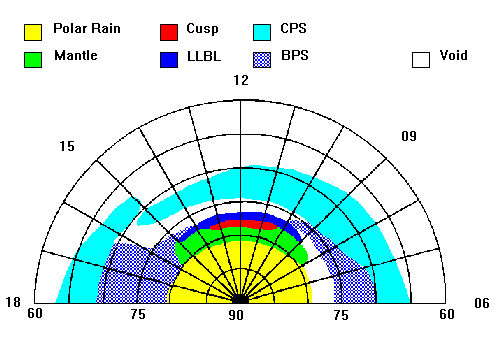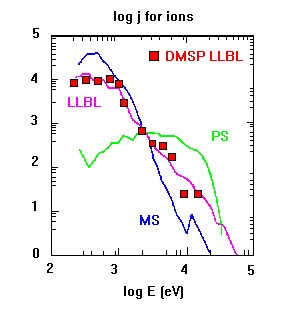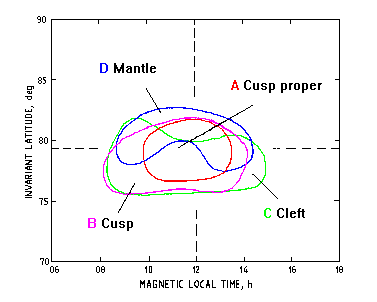 Dayside auroral precipitation
Dayside auroral precipitation Dayside auroral precipitation
Dayside auroral precipitationIt is important to note that, although the low-altitude ionization and visible auroral emissions are created mainly by precipitating electrons, these signatures are not useful in identification of the different plasma regions around the dayside cusp. For example, the much lower fluxes from the LLBL region when compared to the cusp are compensated by the bidirectional electron beams found in the LLBL: the precipitating energy fluxes in the LLBL and the cusp are not that different. Measuring the precipitating electron fluxes directly is more useful, but even that suffers from the variability of the electron signatures. Thus, it is mainly the low energy ion (mostly proton) fluxes that are used in defining the different source regions.
The use of higher energy particles as tracers for different regions is somewhat problematic, for a number of reasons. First of all, it seems that magnetospheric plasma is able to escape into the magnetosheath quite easily. Because of this one can see magnetospheric particles also in the cusp region. Secondly, the interaction of both magnetosheath and plasma sheet ions with the magnetopause current layer is most likely important. It leads to the violation of the first adiabatic invariant, and thus to pitch angle scattering and acceleration of ions.
Note that we won't discuss the very high latitude polar cap precipitation, i.e., polar rain, here.

Dayside auroral distribution according to the precipitating plasma parameters: 'less than reality, but more than a cartoon' (from Newell and Meng, GRL 19, 609-612, 1992)
Note that, in this scheme, names for the low-altitude boundary layer regions (cusp, mantle, and LLBL) refer directly to the corresponding magnetospheric region:

Direct comparison of high- and low-altitude LLBL ion spectra (red dots and line, respectively; from Newell et al., GRL 96, 21013-21023, 1991)
The LLBL has also few times smaller ion densities than the cusp, and the mantle even smaller than that. However, the densities can vary dramatically with solar wind density, making the average energy more reliable indicator for different regions.
One important feature seen in the precipitation distribution is the wide longitudinal extent of the mantle precipitation region. The scheme for the formation of the high-altitude plasma mantle due to direct plasma entry from the cusp (see Boundary layer) cannot explain this. According to it, only the region directly poleward of the cusp, so-called cusp plume, should show mantle precipitation. However, also observations of the mantle current indicate longitudinally much wider mantle than cusp. Although not seen from the figure, the precipitation is indeed much stronger inside the cusp plume. This indicates that an additional, weaker direct entry is taking place at field lines further away from the noon. It is considered unlikely that the additional precipitation would be return flow from the distant tail.
The distribution of the LLBL precipitation is also surprising, indicating that this precipitation would be more often seen pre-noon than post-noon (not seen in the map above). It is thought that this is due to a fault in the automated identification algorithm used, brought by the field-aligned potential acceleration events inside the intense upward region 1 current between 1400-1600 MLT (the 1400 MLT 'hot spot' aurora region).
An important point to note is that the distribution map above has been generated without any ordering of the data according to geomagnetic activity and solar wind/IMF conditions. Because the position of the regions, especially that of the cusp, depend heavily on these parameters, this may introduce some additional spread into the results.
part p+ e- e- acc connected to =================================================== A Cusp proper yes yes no exterior cusp B Cusp yes yes yes entry layer C Cleft no ? yes LLBL D Mantle yes no no mantle

These results differ somewhat from the those of DMSP at lower altitudes.